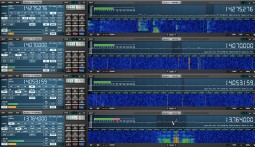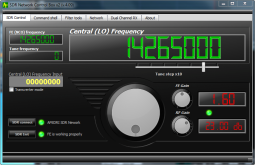the the Control Box Software to a folder and start the SDR_Control.exe program. You should see the Control Box software startup and and check the following items:
- Select the Network Tab
- Enter the new unused default IP address compatible with your router in the SDR IP Address box.
- Check that the SDR IP Mask setting is appropriate for your network. If not change it. (probably not necessary for most networks)
- Go ahead and assign a Gateway IP address that falls within your routers IP range.
- It is not necessary change the Destination IP address (not user selectable). Don’t change the port setting since most SDR programs look for IP activity on this port number.
- If you want to be able to use the Afedri SDR-Nets full Lan bandwidth check that the Network Sample Rate is set to 1333333.
- Click the Save button and shut down the Control Box software.
- Connect a standard Lan cable between the router and the Afedri Net-SDR.
- Restart the Control Box software, if you were successful, you should see a green light by the Afedri SDR Network label and the FE label.
- You can keep the USB cable plugged in for power if you wish or use another source of power.
- Check the Enable Network Interface box and the network interface should now be active.
- If you run into problems, one thing to check is to see if your router is blocking port 50000. Most routers will allow you to open a port for traffic, but you will have to do a little research on how to do that on your own particular router.
Ok, if all that went well, you can now start. SDR-Radio.com, but this time select Afedri SDR – (Lan). Again have SDR-Radio.com search for the Afedri SDR-Net. If all goes well, you should see the Afedri SDR-Net Lan listed. When you start this configuration the displayed bandwidth should be about 1225KHz (nice). This should for example allow you to easily monitor the activity of say the entire 20 Meter amateur radio band plus some.
Connecting the Afedri SDR-Net via also offers other advantages besides the expanded bandwidth. As we mentioned earlier, the Lan connection will allow other computers on your local area network to use the Afedri SDR-Net. SDR Radio.com will even let you share the Afedri SDR-Net with other SDR Radio.com users around the world by setting up a SDR server. You can also place the Afedri SDR-Net in a remote location and access it via the network. Another advantage is by using a long piece of ethernet cable and a USB power supply, you can move the Afedri SDR-Net closer to your antenna connection and away from your RF generating computer for quieter operation. You can also connect the Afedri Net-SDR to a Wireless Bridge and eliminate the ethernet cable if you want to. Just be sure you are using a robust wireless network.
Using the Afedri SDR-Net with other SDR Software

The Afedri SDR-Net will also work with popular SDR radio Software that is ExtIO friendly. We used the Afedri SDR-Net with HDSDR and Studio1 without any issues. To use these programs, you have to set up the Afedri SDR-Net a little differently. Programs such as HDSDR and Studio1 require you to install the Control Box software into their program directory. The simplest way to accomplish this is by just copying all the files that are provided in the Control Box folder to the HDSDR or Studio1 program directory. When you start the SDR program, the Control Box application should start along with it. The SDR software will control the tuning and decoding of the IQ signals. The Control Box software allows you to set other settings unique to the Afedri SDR-Net such as the FE Gain and VGA Gain controls which may be necessary to tweak the Afedri SDR-Net to perform best for your antenna and location. Normally when using HDSDR or Studio1, the gain controls are probably all you will need to adjust.
The Afedri SDR-Net Control Box
The Afedri SDR-Net Control box deserves a mention all on its own. First of all, kudos to Alex for designing such a nice looking interface. Most SDR utility

programs look just utilitarian. Alex did a great job of making the Control Box look attractive, if it has to be on your computer screen. However, the Control Box is more than just a pretty face. As mentioned above, one of the functions of the Control Box is to provide an interface between the Afedri SDR-Net and ExtIO enabled SDR programs. However, the Control Box can be used as a standalone tuning control for your SDR software if you wish. Also for SDR software that does not support ExtIO interfaces, you could use the Control Box to set the center frequency for the program. More than likely you will be using the Afedri SDR-Net with SDR programs that do support ExtIO and the Control Box can be placed in the background. However, the Control Box is still an important part of the Afedri SDR-Net when being used with ExtIO enabled programs because it lets you set the FE Gain and VGA Gain of the Afedri SDR-Net. If you are going to be using the Afedri SDR-Net on a Lan, you will also want to take a look at the Network section of the Control Box. As mentioned above, this is where you can customize network settings to better suit your own Lan environment. The Command Shell area is where you can change some of the more advanced settings of the Afedri SDR-Net. You probably should not change anything here, unless you seriously know what you are doing. The Dual Channel Rx is only functional with the new dual channel Afedri SDR-Net. The About section allows you to put the Afedri SDR-Net into mode to allow for firmware upgrades.

Hi Mike,
in the first part of the video what sdr software is that? thanks Beau
SDR Radio.com V2 available from http://v2.sdr-radio.com
Your review is inaccurate when you talk in terms of the Afedri SDR-Nets’ nearest competition being the RF Space NetSDR. You have omitted the Perseus at $1000 and the Winradio Excalibur at $900
True, but we felt the nearest competitor was the NetSDR because it was one of the few SDRs that has an IP interface.
Very nice review and based upon it I’ll probably get an order in for the radio.
Thanks!
George
N7BUI
A few comments…
Why is it manufacturers still keep putting connectors on the front of these SDR boxes. On an average users desk , all those connectors would be best placed at the rear,, with indicator lights on the front ??
Also I would like to see a power on /off rather switch as opposed to an always on when connected to USB?
Hi,
I bought a AFERDI SDR about 2 months ago and I have to say its one of the best under $300 SDR receivers you can get.
For the price you get a very capable receiver that works well. I prefer using HDSDR as the software to control it. It receives everything my Icom R75 / TenTec RX-320D receives. If you have any questions feel free to contact me.
Kelvin
can this product be used with an indoor antennaa or is that just a waste of time?
Yes, it is no different from any other radio. The better the indoor antenna the better it will work!
I don’t know the internals of this SDR being reviewed (so I may be wrong), but a direct-conversion quadrature synchronous detector (DC-QSD, alternatively known as a Tayloe detector) without an active front-end and/or some form of matching has both gain and bandwidth that is rather strongly dependent on the antenna match. In my experience (Softrocks), this is rather unlike a “regular” receiver. I suggest you read Gerald Youngblood’s four-part QEX articles “A Software Defined Radio for the Masses”, which is free to download from the ARRL Web site (ask Google). Mr. Youngblood explains this in-detail.
Can this unit function as a second/sub receiver to radios that have an IF output such as an Elecraft K3, etc.? If so, what is the IF frequency it can use?
You can use the net SDR with its different IP address with many routers, you just need to set it up on its own subnet and use routing. If your router supports multiple ports, set up one of the ports as a route to the desired subnet. This is easy to do with a better 3rd party router firmware (one example, openwrt) as well as some OEM router firmware. Each ethernet port should have its own designation, for example eth0, eth1, eth2 Google for specific instructions for your router.
Did you ignore the FunCube ProPlus Dongle on purpose of because it doesn’t come with LED’s and a metal box? It already covers way more spectrum than this receiver (from 150kHz thru 1200Meg) and it’s the size of a flash drive.
Nope, just did not have one to review 🙂
The AfedriSDR Net v.3 has a sample rate up to 2000 kHz, the FCPPD is cool too but currently only goes to 192 kHz, granted it’s range is greater. I think the main point here though is the NET (ethernet) capability and though not mentioned directly, is the AFEDRI’s ability to be operated remotely.
Woot, I will ceritanly put this to good use!
A very nice Mac and Windows program called SDRDx also supports the Afedri SDR.
Looks nice and sounds good too.
How does it compare to the Alinco DJ-X11T using
the SDR software on the Alinco.
Much larger spectrum display. The DJX11 has very narrow bandwidth and is not quite as sensitive on HF. However, the DJX11 does pretty well seeing how it also includes VHF.
If you don’t want to cry while doing your hobby this SDR is the right choice.
If you have 1000 Euro + to spend I would recommend something more solid to play with and not an SDR like Perseus etc.
Supposing that a person had a €1000+ to spend. What would you consider to be more solid as a device? I’m guessing it would be a device that needed an RF front end adding to it?
@SuperWave
Supposing that a person had a €1000+ to spend. What would you consider to be more solid as a device? I’m guessing it would be a device that needed an RF front end adding to it?
Nice to see an IP radio so low cost. I may have to look at getting one to play networking?
Anyone know what the minimum specification of the PC need to run this SDR please.
so this is only for hf ?
Yes
How do you change its IP settings?
have a look at AFEDRI v3.0 There are some improvements and promises better result. Alex 4Z5LV is a great electronic designer.
73! L.